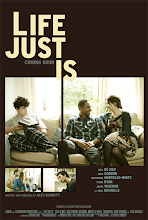I decided fairly early on in the process of developing the style of Life Just Is that I didn't want to use a traditional score, and that the only music in the film would be diegetic (i.e. that it would come directly from within the world of the film in moments where, for instance, the characters themselves are listening to music on a stereo). The main idea behind this was that I wanted to avoid any kind of manipulation of audience emotion: I wanted to see if I could draw out an emotional response to the film purely through audience identification with the characters and their situations, rather than through a few strings ringing out on a soundtrack. Rereading Robert Bresson's Notes on the Cinematographer during development no doubt also contributed, with three of his maxims never straying too far from my mind:
'Build your film on white, on silence and on stillness'
'Be sure of having used to the full all that is communicated by immobility and silence'
'No music as accompaniment, support or reinforcement. No Music at all*.
The noises must become the music.
*Except, of course, the music played by visible instruments'
Conflicting with these ideas, though, was another: that of Life Just Is as a covert musical, in which characters sing to one another and in which music clearly plays an important part.
So, the point was never so much to abandon music as to use it in a way that mutually supported the characters and the story, without resorting to the falsification of the moment or fabrications of emotions that traditional scores can sometimes bring.
With all that in mind, finding the right music for the film became extremely important.
It's therefore with great pleasure that I'm now able to announce, for the first time, our full soundtrack listing!
I know it's very easy to be hyperbolic when writing a piece like this (we are trying to promote a film here, after all), but what makes this announcement even more exciting is that some of the bands listed below are among my all-time favourites. I feel incredibly privileged to have been allowed to use their music, and I'd like to thank everyone involved for their kindness and support. I'm genuinely touched. The Wildhearts have been my favourite band since I was nine years old, and being able to use their music in my debut feature is something of a dream come true.
It was through The Wildhearts that I discovered some of the other bands listed, including Deckard, who I first came across when their singer supported The Wildhearts' frontman Ginger during an acoustic tour some seven or eight years ago, and The Jellys and Plan A (both of whom feature ex-Wildhearts members, and both of whom are now sadly inactive).
Another sadly inactive band is The Lustjunks, who were a regular fixture on my local music scene when I was growing up. I always seriously loved their stuff, and I'm glad that I was able to track them down and include them here. (I can also exclusively reveal that Andy, their frontman, is working on a new album – so that's certainly something to keep an eye out for!) Also culled from my local music scene is the terrifying, crushing behemoth that is nate_seacourt, who can currently be seen tearing apart venues across London (literally).
The rest of the bands came to me through our music supervisor, James McWilliam, and although I didn't know many of them until Jim suggested them, I'm no less excited about using their music in the film. Thanks to Jim's hard work and the generosity of the bands he contacted, I think we've managed to put together a genuinely interesting, exciting and eclectic sound track: Animal Kingdom have just finished recording their second album with producer David Kosten, The High Wire recently supported Coldplay across multiple dates during their Viva La Vida arena tour, and The Heart Strings' second album will be getting a physical release in January 2012.
Anyway, that's enough of my waffling – I'll let you have a listen for yourself...
- Alex
Music tracks and artists featured on our soundtrack, listed in order of appearance:
(Where possible, song names link to Spotify/Soundcloud tracks, band names to official websites. To download the free MP3s please right click and 'Save Target As...')
And Rear Lights - The Lustjunks (free MP3 download)
Drunk Love - Emma McGlynn (free MP3 download)
On My Mind - Will De Meo
Lemonade Girl – The Jellys
Dreaming in A – The Wildhearts


























































